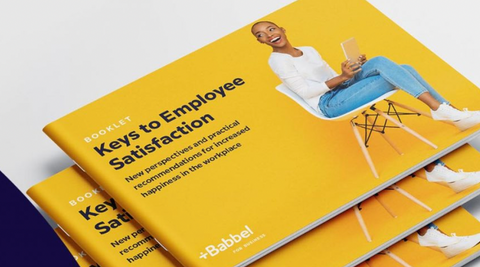In this post, we explain what employee experience (EX) means and why it’s crucial for business. We also outline the 5 essential pillars of employee experience and show you, in 5 actionable steps, how to improve the EX at your company.
Employee experience (EX) has become a major buzzword in the business world. Good EX is synonymous with employee engagement and happiness — while bad EX spells low engagement and high turnover.
As the competition for top talent heats up, more and more employers are treating the employee experience as a top priority. But with so many contributing factors, getting the employee experience right can be a tricky task.
In order to optimize the employee experience, it’s important to understand all the individual factors which shape it — and to translate them into a holistic EX strategy.
Are you ready to level up your employee experience? Keep reading to learn:
- What is employee experience (EX) and why does it matter?
- The 5 essential pillars of employee experience
- Which individual elements and factors shape the employee experience?
- How to provide an exceptional employee experience (5 steps)
Let’s begin with a definition in the next section.

How can you keep employees happy and engaged?
Discover specific ways to increase employee happiness in our free booklet “The Keys to Employee Satisfaction.” Download it now!
What is employee experience (EX) and why does it matter?
Employee experience (EX) is one of the most important focus areas for HR leaders this year — if not the most important.
When we talk about employee experience, we’re describing the end-to-end experience an employee has with a company. It’s the sum of everything they experience in relation to their job: the tools they use, their workspace, the tasks and projects they work on, interactions with their managers and colleagues, the opportunities they receive to learn and grow, the general company culture around them — and much, much more.
All of these touchpoints accumulate to shape the overall employee experience. Essentially, it all boils down to how it feels for an employee to work for a certain employer.
Why employee experience (EX) is crucial
There’s a reason that 47% of HR leaders have identified employee experience as a top strategic priority.
The employee experience has a major impact on employee engagement, performance, and retention — all of which are critical when it comes to winning the war for talent and addressing the root causes of quiet quitting.
When you consider that low employee engagement costs companies an estimated $450-550 billion each year in the U.S. alone — and that happy employees are 13% more productive than their dissatisfied peers — it’s clear that employee experience is a crucial factor for business success.
Ultimately, employers who want to attract, retain, and nurture happy, high-performing employees who are engaged in their work must provide a positive employee experience.
With that in mind, let’s consider all the various elements that make up the employee experience.

The 5 essential pillars of employee experience
The overall employee experience (EX) is shaped by many different factors. These fall into the following categories, which you can think of as your 5 essential employee experience (EX) pillars:
- Job-related factors — how easy (and enjoyable) is it for employees to do their work on a day-to-day basis?
- The social experience — the employee’s experience of team dynamics, their sense of belonging, and how they feel about the people they work with.
- Organizational and environmental factors — how is the organization set up, i.e. what systems and technologies are in place? How is the physical or virtual working environment?
- Growth and fulfillment — the employee’s overall job satisfaction and what kinds of opportunities they have to learn and grow.
- Company culture — shaped by company values, policies, and behavioral norms across the organization.
Now let’s drill down to some of the most important individual factors within these pillars.
Which individual elements and factors shape the employee experience?
If you want to provide a great employee experience, you need to know which elements shape the employee experience in the first place. It’s impossible to list every single contributing factor, but we’ll outline the most important ones within each pillar.
Job-related factors
- Access to tools and resources which allow the employee to do their work efficiently
- Processes which help the employee to reach their goals
- Clarity regarding the employee’s role
- Flexibility and autonomy over tasks
The social experience
- Psychological safety
- Team dynamics and peer-to-peer relationships
- Management and leadership
- A sense of belonging and connectedness
- Diversity and inclusion
Organizational and environmental factors
- The quality of the employee’s physical and/or virtual workspace
- Hiring and recruitment practices and processes
- The employee onboarding experience
- Leadership and team structures
- Corporate benefits
- Employee well-being
Growth and fulfillment
- Learning and development opportunities
- Opportunities for career progression
- Feedback
- Recognition and reward
- Connection to the company’s mission and purpose
- A sense of achievement
Company culture
- Company values and traditions
- Policies
- Work-life balance
- Transparency and trust
- Communication styles
Moving through that list, you’ll see that there’s not always a clear distinction between the pillars. Many employee experience (EX) factors fall into several categories at once. That’s why it’s so important to consider the employee experience holistically.

How to provide an exceptional employee experience: 5 key steps
We know what employee experience is and the key factors that shape it. Now let’s outline some concrete steps you can take to improve the EX at your company.
Here are our top 5 measures for a better employee experience:
- Optimize the employee onboarding experience
- Set people up for success with the right tools and resources
- Create a healthy feedback culture
- Invest in employee development
- Make your employee experience measurable
Let’s take a look at how you can get started with each of these steps.
1. Optimize the employee onboarding experience
Employee onboarding is one of the first (and most crucial) aspects of the employee experience. According to a survey conducted by CareerBuilder and SilkRoad Technology, nearly 10% of employees have left a new company because of a poor onboarding experience.
We know how costly employee turnover can be — up to double the employee’s salary, according to some reports. And, even if a bad onboarding experience doesn’t scare an employee away, it will set the tone for the rest of their time with your company.
So how can you improve the employee onboarding experience? Here are some tips and best practices:
- Start with preboarding: You can begin the onboarding experience before the employee’s official start date. Send them an agenda so they know what to expect on their first day and encourage them to ask any questions ahead of time.
- Make it collaborative: Don’t just have new hires filling out forms and reading through paperwork in their first week. Schedule in time for them to meet with their new team members and have regular check-ins with their manager.
- Set goals: There’s nothing worse than starting a new job and not knowing what’s expected of you. Set short and mid-term goals during the onboarding phase so the employee knows how the next few months will play out.
For more ideas and best practices, check out these 9 employee onboarding trends for 2023.
2. Set people up for success with the right tools and resources
Employees can only succeed if they’re set up to do so. If they’re constantly battling with inadequate tools or a lack of resources, they’ll wind up frustrated, unsatisfied, and probably looking for another job.
In a global survey of over 9,000 workers, an incredible 91% reported being frustrated due to inadequate technology in the workplace. Even more worrying: 49% said that inadequate workplace technology causes them to feel stressed, with 48% claiming it has negatively impacted their mental health.
Among the main complaints were slow tools and technology, a lack of collaboration between departments, and missing important features and capabilities. For leaders, one of the biggest issues is that employees are not given enough time to learn new software.
Having the right tools and resources to do their job (and to do it well) is a huge part of a positive employee experience. Here are some proactive steps you can take to equip your employees for success:
- Ask your employees what they need: It sounds simple, but it’s often overlooked. Check in with your employees to find out what tools they’re missing or what pain points they’re experiencing with their current tools.
- Provide thorough training: Make sure your employees know exactly how to use all tools, software, and platforms — and ensure that training is personalized and role-specific.
- Ensure you have adequate tech support available: In the aforementioned survey, 34% of respondents identified ‘extended response times from IT teams’ as a pain point. Establish guidelines around what’s a reasonable waiting time for tech support (just as you would for customers) and make sure you have enough staff available to keep things running smoothly.
As you optimize your tool stack, bear in mind how the work environment has changed in recent years.
3. Create a healthy feedback culture
In a healthy feedback culture, everybody feels empowered to share both positive and constructive feedback — and knows how to do so effectively and respectfully.
A good feedback culture enhances the employee experience (EX) by boosting engagement, making employees feel valued, and building trust. An Officevibe survey found that 43% of highly engaged employees receive feedback at least once a week, while 40% of employees are actively disengaged when they receive little or no feedback. Interestingly, 65% said they wanted more feedback.
Feedback is also linked to employee recognition — which in turn boosts productivity. 69% of employees said they would work harder if their efforts were better recognized through feedback.
Here are some ways you can build and foster a healthy feedback culture:
- Provide feedback training: It’s important to establish norms and expectations around feedback, including how to give feedback constructively and respectfully. Whether it’s a formal workshop or a simple set of company-wide guidelines, training will help to instill feedback as part of the company culture.
- Make sure feedback is meaningful: Not all feedback is useful feedback. There’s a big difference between giving someone a generic “Well done” and actually specifying what they did well. Encourage personalized, meaningful feedback that makes your employees feel seen.
- Use multiple channels to deliver feedback: The best way to integrate regular feedback into the day-to-day workings of your company is to use multiple channels and “feedback opportunities.” For example, you don’t need to wait until you’re next in a meeting with a colleague to share your feedback, and you certainly shouldn’t wait until performance reviews — use tools like Slack to make feedback a regular and natural occurrence.
Feedback doesn’t only help to keep employees engaged. It enables them to continuously learn and adapt, and encourages a sense of ownership over their work. And as a crucial pillar of healthy communication, it generally makes for a more positive workplace.
Workations are popular employee benefits that can help your employees feel less stressed and prevent burnout. In episode 13 of our podcast, we discover how they also make employees feel empowered and inspired. Listen here:
4. Invest in employee development
Employee training and development is crucial for addressing skills gaps and keeping up with the ever-changing world of work. It’s also an important part of the employee experience.
At the beginning of 2023, Cornerstone OnDemand, Inc. conducted a global research study into talent mobility. They found that 73% of modern workers want to know about career opportunities within their organization. They also found that employees who are able to use technology (e.g. an internal database) to explore different career opportunities within their company are 50% less likely to quit their jobs compared to those who don’t have any visibility into such opportunities.
So how can you make employee growth and development a core part of the employee experience? Consider the following:
- Promote internal mobility: As mentioned previously, internal career opportunities are a major point of interest for today’s workers. Make career opportunities within your organization visible and accessible to all employees, especially through technology and internal careers portals.
- Provide personalized learning and development pathways: Employees want training and progression opportunities which align with their own goals and aspirations. Take the time to discuss each individual employee’s learning and development needs, and leverage technology to devise custom training plans.
- Leverage the latest learning and development trends: With so many different tools and technologies available, employers have the opportunity to make learning and development more engaging than ever. Take note of key L&D trends such as microlearning, gamification, and social learning to enhance the training experience.
Employee development is a critical step towards employee satisfaction and fulfillment at work — and, as such, a crucial aspect of the overall employee experience.
For more insights and best practices about employee development, check out the new way to upskill your employees.
5. Make your employee experience measurable
Employee experience (EX) is a rather abstract concept, but it should still be treated as a strategic initiative. Whatever steps you take to improve the employee experience, it’s important that you’re able to track and measure your success.
You can make the employee experience measurable by tracking relevant metrics and KPIs (key performance indicators). Some of the most important EX KPIs include employee satisfaction, employee engagement, net promoter score (NPS — how likely an employee would be to recommend you as an employer), absenteeism, and retention.
All of these measures together will give you a good indication as to how satisfied your employees are with their overall experience — and highlight key areas for improvement. Here are some tips to help you with tracking the employee experience:
- Conduct regular EX ‘health checks’: Anonymous surveys are a great way to get feedback from your employees and turn qualitative feelings and perceptions (e.g. employee engagement) into quantitative data (for example, an average engagement score of 7 out of 10).
- Use technology: HR software and employee analytics are extremely valuable tools for pulling up key data and identifying trends. For example, if you notice a high rate of absenteeism across your employee population, this could be a red flag for your employee experience.
- Go beyond data to track the employee experience: Beyond surveys and analytics, keep your finger on the EX pulse simply by checking in with your employees regularly. If you have weekly one-on-one meetings with your team members, ask them how they’re doing and if there’s anything they’re struggling with. This will alert you to pain points as they arise — and enable you to fix them sooner rather than later.
Whatever data and insights you gather about the employee experience, it’s essential that you act on them. Improving the employee experience is an iterative, ongoing process — listen continuously to your employees’ needs and adapt accordingly.
Improving employee experience (EX): the takeaway
The overall employee experience (EX) is critical for nurturing employee well-being, keeping your teams engaged, and avoiding high turnover.
There are many different elements which shape the employee experience. Optimize the individual EX pillars as outlined in this post (job-related factors, the social experience, organizational and environmental factors, growth and fulfillment, and company culture) and you’ll see an overall improvement in your employees’ engagement and happiness.
And remember: like any other strategic initiative, employee experience (EX) should be tracked, measured, and optimized continuously.

How can you keep employees happy and engaged?
Discover specific ways to increase employee happiness in our free booklet “The Keys to Employee Satisfaction.” Download it now!





